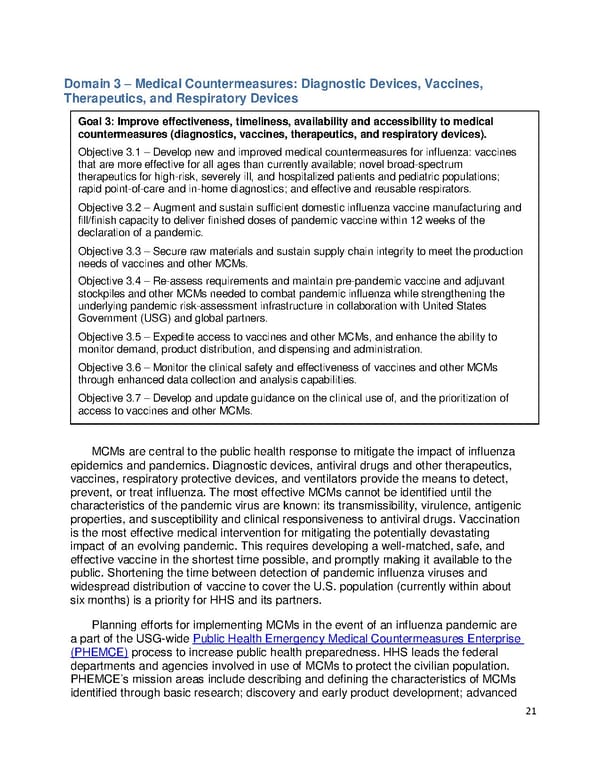Domain 3 – Medical Countermeasures: Diagnostic Devices, Vaccines, Therapeutics, and Respiratory Devices Goal 3: Improve effectiveness, timeliness, availability and accessibility to medical countermeasures (diagnostics, vaccines, therapeutics, and respiratory devices). Objective 3 .1 – Develop new and improved medical countermeasures for influenza: vaccines that are more effective for all ages than currently available; novel broad-spectrum therapeutics for high-risk, severely ill, and hospitalized patients and pediatric populations; rapid point-of-care and in-home diagnostics; and effective and reusable respirators. Objective 3.2 – Augment and sustain sufficient domestic influenza vaccine manufacturing and fill/finish capacity to deliver finished doses of pandemic vaccine within 12 weeks of the declaration of a pandemic. Objective 3.3 – Secure raw materials and sustain supply chain integrity to meet the production needs of vaccines and other MCMs. Objective 3.4 – Re-assess requirements and maintain pre-pandemic vaccine and adjuvant stockpiles and other MCMs needed to combat pandemic influenza while strengthening the underlying pandemic risk-assessment infrastructure in collaboration with United States Government (USG) and global partners. .5 – Expedite access to vaccines and other MCMs, and enhance the ability to Objective 3 monitor demand, product distribution, and dispensing and administration. Objective 3 .6 – Monitor the clinical safety and effectiveness of vaccines and other MCMs through enhanced data collection and analysis capabilities. Objective 3 .7 – Develop and update guidance on the clinical use of, and the prioritization of access to vaccines and other MCMs. MCMs are central to the public health response to mitigate the impact of influenza epidemics and pandemics. Diagnostic devices, antiviral drugs and other therapeutics, vaccines, respiratory protective devices, and ventilators provide the means to detect, prevent, or treat influenza. The most effective MCMs cannot be identified until the characteristics of the pandemic virus are known: its transmissibility, virulence, antigenic properties, and susceptibility and clinical responsiveness to antiviral drugs. Vaccination is the most effective medical intervention for mitigating the potentially devastating impact of an evolving pandemic. This requires developing a well-matched, safe, and effective vaccine in the shortest time possible, and promptly making it available to the public. Shortening the time between detection of pandemic influenza viruses and widespread distribution of vaccine to cover the U.S. population (currently within about six months) is a priority for HHS and its partners. Planning efforts for implementing MCMs in the event of an influenza pandemic are Public Health Emergency Medical Countermeasures Enterprise a part of the USG-wide (PHEMCE) process to increase public health preparedness. HHS leads the federal departments and agencies involved in use of MCMs to protect the civilian population. PHEMCE’s mission areas include describing and defining the characteristics of MCMs identified through basic research; discovery and early product development; advanced 21
 Pandemic Influenza Plan Page 20 Page 22
Pandemic Influenza Plan Page 20 Page 22